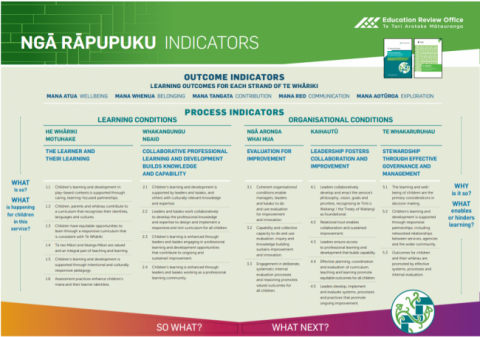
Outcome Indicators
Learning outcomes for each strand of Te Whāriki
- Mana Atua Wellbeing
- Mana Whenua Belonging
- Mana Tangata Contribution
- Mana Reo Communication
- Mana Aotūroa Exploration
Process Indicators
Learning conditions
He Whāriki Motuhake The learner and their learning
1.1 Children’s learning and development in play-based contexts is supported through caring, learning-focused partnerships.
1.2 Children, parents and whānau contribute to a curriculum that recognises their identities, languages and cultures.
1.3 Children have equitable opportunities to learn through a responsive curriculum that is consistent with Te Whāriki.
1.4 Te reo Māori and tikanga Māori are valued and an integral part of teaching and learning.
1.5 Children’s learning and development is supported through intentional and culturally responsive pedagogy.
1.6 Assessment practices enhance children’s mana and their learner identities.
Whakangungu Ngaio Collaborative professional learning and development builds knowledge and capability
2.1 Children’s learning and development is supported by leaders and kaiako, and others with culturally relevant knowledge and expertise.
2.2 Leaders and kaiako work collaboratively to develop the professional knowledge and expertise to design and implement a responsive and rich curriculum for all children.
2.3 Children’s learning is enhanced through leaders and kaiako engaging in professional learning and development opportunities that contribute to ongoing and sustained improvement.
2.4 Children’s learning is enhanced through leaders and kaiako working as a professional learning community.
Organisational conditions
Ngā Aronga Whai Hua Evaluation for Improvement
3.1 Coherent organisational conditions enable managers, leaders and kaiako to do and use evaluation for improvement and innovation.
3.2 Capability and collective capacity to do and use evaluation, inquiry and knowledge building sustains improvement and innovation.
3.3 Engagement in deliberate, systematic internal evaluation processes and reasoning promotes valued outcomes for all children.
Kaihautū Leadership fosters collaboration and improvement
4.1 Leaders collaboratively develop and enact the service’s philosophy, vision, goals and priorities, recognising te Tiriti o Waitangi / the Treaty of Waitangi as foundational.
4.2 Relational trust enables collaboration and sustained improvement.
4.3 Leaders ensure access to professional learning and development that builds capability.
4.4 Effective planning, coordination and evaluation of curriculum, teaching and learning promote equitable outcomes for all children.
4.5 Leaders develop, implement and evaluate systems, processes and practices that promote ongoing improvement.
Te Whakaruruhau Stewardship through effective governance and management
5.1 The learning and well-being of children are the primary considerations in decision making.
5.2 Children’s learning and development is supported through responsive partnerships, including networked relationships between services, agencies and the wider community.
5.3 Outcomes for children and their whānau are promoted by effective systems, processes and internal evaluation.